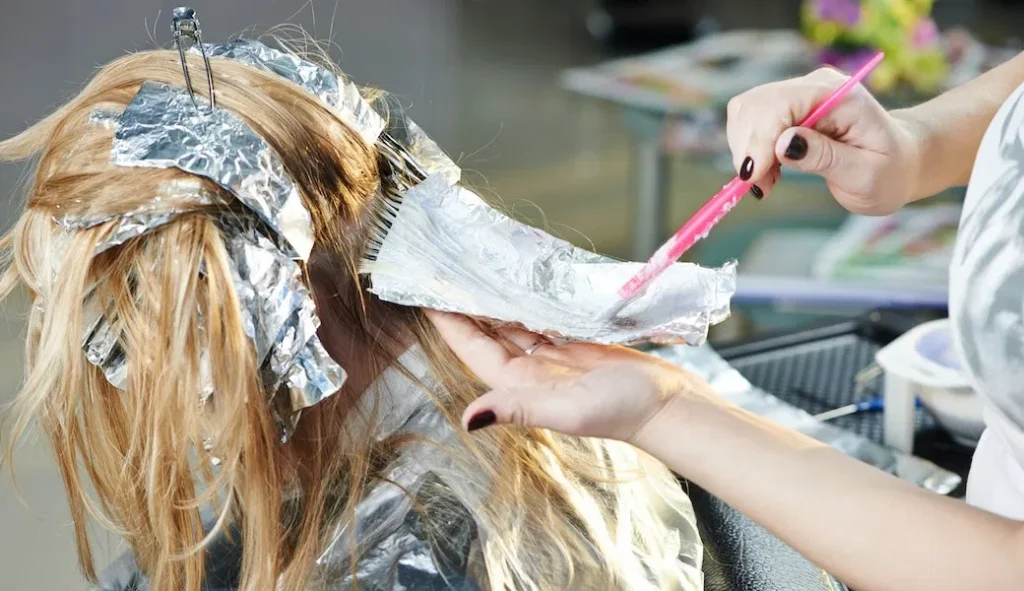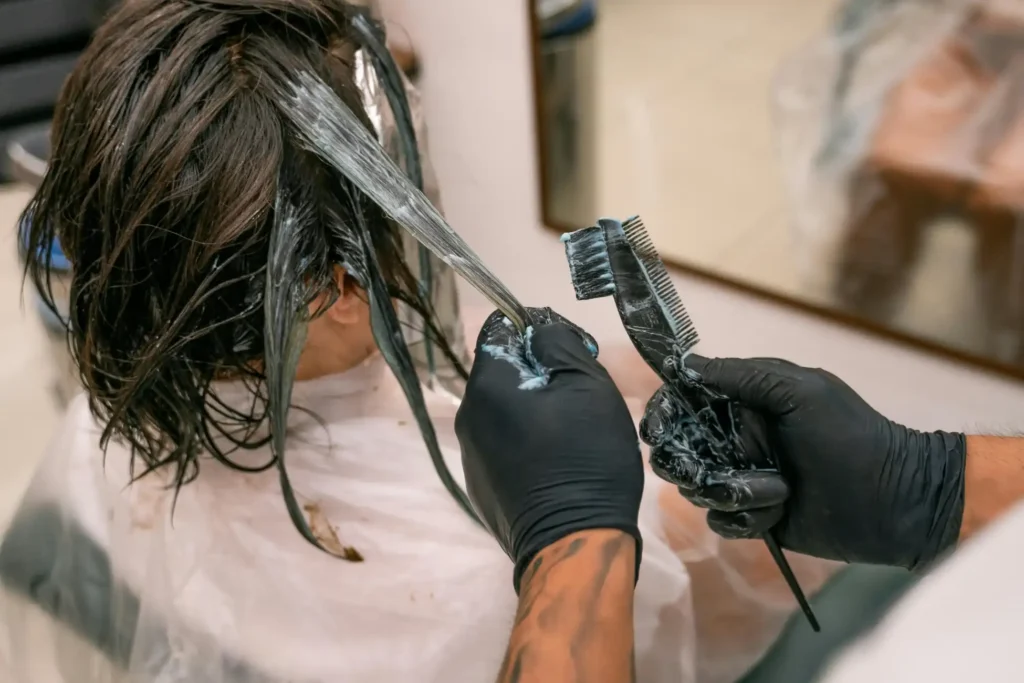Whether your goal is platinum blonde or preparing your hair for vivid colours, bleaching can be an exciting approach to changing your appearance. However, to guarantee that your hair stays healthy and robust, the hair bleaching process does, however, need thorough preparation and aftercare. This article will guide you through all you need to know about bleached hair and how to care for it following treatment. We have covered everything from selecting the proper hair bleach to determining how long to leave bleach in your hair.
Hair Bleaching Process: What to Expect
Using a chemical solution, the hair bleaching process removes the natural pigment from your hair, so it lightens it. Applying bleach to your hair causes the chemical mixture to open the hair cuticle and dissolve the natural melanin—the pigment that gives your hair its colour. Your hair will be lighter and more receptive to absorbing various dyes, including pastel or blonde tones.
Your hair may suffer from the bleaching process really harshly. If done incorrectly, it could cause split ends, dryness, and breaking. Bleached hair care is therefore absolutely crucial following the treatment. Later on, we will discuss aftercare advice; first, let us review the bleaching processes.
Hair Bleach: Types and How to Choose the Right One
Choosing the right hair bleach depends on your hair type and your desired results. If you’re unsure, consult with a professional to avoid unnecessary damage. Regarding hair bleach selection, there are numerous choices at hand. The two most often used varieties are cream bleach and hair bleach powder. Though they have different uses, both forms can be successful.
- Usually, hair bleach powder is blended with a developer to form the bleaching solution. It is powerful and can considerably lighten hair. Those with dark hair or those seeking a significant transformation are generally advised to powder bleach.
- Although cream bleach is easier to use and less harsh than powder bleach, it might not correctly lift colour.
Your desired outcomes and type of hair will determine the correct hair bleach for you. If you’re doubtful, see a specialist to prevent unneeded damage.
A Comprehensive Guide on Bleaching Hair, Step-by-Step
Here’s a detailed step-by-step instruction to get you started if you’re wondering how to bleach hair at home:
- Get your hair ready: Start with dry, clean hair, and apply no strong styling products before bleaching.
- Hair Selection: To guarantee an even application, separate your hair into little pieces.
- To mix the bleach: Mix the bleach and develop according to the directions on your hair bleach kit.
- Applying bleach: Work your way up to the roots beginning from the ends of your hair. Apply the bleach consistently, then.
- Watch for the bleach to process: Watch the time; later on, we will go over how long to leave bleach in the hair.
- Rinse and fix: Rinse the bleach entirely and give your hair a deep conditioner to moisturize it once the processing time is done.
Bleach Bath Hair: A Gentle Alternative
One softer way to lighten your hair is with a bleach bath. For people who just want to raise their color a few tones, it’s perfect. Under a bleach bath, damp hair is treated with bleach mixed with shampoo. Though it takes more time to get desired results, this approach is less severe than conventional bleaching.
A bleach bath could be the best option for you if you desire a subdued lightening effect or worry about hurting your hair.
Hair Bleach Powder vs. Cream: What’s the Difference?
As was already indicated, cream and hair bleach powder have various uses. For extreme color changes—especially for black hair—powder bleach often is stronger and more efficient. Although cream bleach is less harmful and easier to apply, many applications may be necessary to get the intended lightness.
While people with darker hair could find hair bleach powder more effective, those with sensitive hair or scalp could want cream bleach.
Bleach and Hair: Understanding the Science Behind It
Knowing the science behind bleach can help you to better grasp how it changes your hair. Perfect harmony between bleach and hair is not always possible By dissolving the protein structure of the hair, bleach weakens it and increases its breakability. Repeated bleaching over time can leave hair feeling brittle and dry.
For this reason, bleached hair care is critical. Your hair is susceptible to bleaching and should be kept healthy by moisturizing treatments and products.
Hair Bleach Kit: What to Look for When Buying One
A professional-quality home result depends on a reliable hair bleach kit. Though some kits contain extras like toners or conditioners, most packages include hair bleach powder, developer, gloves, and directions. Make sure a bleach hair colour kit consists of all you need for an excellent at-home bleach procedure.
To preserve your hair following a bleaching, search for a kit including a nourishing aftercare treatment and a high-quality developer (20–30 volume is usual for at-home use).
Bleached Hair Men: Trends and Care Tips
Celebrities and influencers adopting this bold appearance have helped the bleached hair men’s trend to flourish. Though shorter hair lengths may call for alternative application methods, bleaching hair follows the same process for males as it does for women.
Men who bleach their hair should use the same bleached hair care regimen, which calls for frequent conditioning, protein treatments, and limited heat styling to stop more damage.
Can one bleach wet hair? Stories Against Data
One often-asked question is, “Can you bleach wet hair?” The quick response is indeed accurate, but cautiously. Often applied during bleach baths, bleaching wet hair can produce a more subdued lightening effect. However, using bleach on damp hair can be erratic, and the effects might not be as striking.
For more exact results, bleaching dry hair is usually safer.
Dyed / Bleached Hair Treatment: How to Repair Damaged Hair
Should you have already bleached or coloured your hair, a proper dyed / bleached hair treatment is essential for restoring its natural condition. Search for deep conditioning treatments featuring moisture and protein. These treatments will stop more breakage and assist to restore the hair shaft.
Frequent use of oils, leave-in conditioners, and hair masks helps your bleached hair remain smooth, lustrous, and controllable.
How Long to Leave Bleach in Hair: Timing for Best Results
Avoiding damage to your hair depends on knowing how long to leave bleach in hair. Depending on the thickness, color, and desired outcomes of your hair, you should keep bleach in for 20 to 45 minutes generally.
To prevent overprocessing, always follow the directions on your bleach kit and routinely examine your hair during the bleaching process.
Best Bleach for Dark Hair: What to Look For
Finding the best bleach for dark hair is crucial if you have dark hair in order to get the lightest shade feasible. Search for a bleach with a high-lift mix meant especially for dark hair that can raise many levels in one application.
Though they should be used carefully to avoid over-damaging the hair, professional-grade treatments usually work best for dark hair.
Deep Conditioning Alternatives: Perfect Hair Mask for Bleached Hair
Your hair will probably need some major TLC once you bleach. The best hair mask for bleached hair is one emphasizing hydration and repair. Search for masks with elements like keratin, argan oil, and shea butter to help restore moisture and rebuild the protein structure of your hair.
Once or twice a week, the use of a hair mask will maintain soft and manageable bleached hair.
Moisturizing and Color-safe Best Shampoos for Bleached Hair
Sulfate-free, moisturizing shampoo is the best shampoo for bleached hair since it helps to stop additional drying out of your hair. Additionally excellent options are shampoos meant for color-treated hair as they guard the color and stop fading.
To tone brassiness and maintain fresh, brilliant hair, think about using a purple shampoo.
Bleach Hair Color Kit: What’s Included and How to Use It
Usually, a bleach hair color kit includes gloves, developer, hair bleach powder, and directions. Specific kits could also include a deep conditioner or toner.
Using a bleach hair colour kit is easy: follow the directions closely, apply the bleach evenly, and remember to condition your hair afterwards to prevent damage.
How Long Should One Keep Bleach in Their Hair? Safe Time Limit
The most often asked query is how long to keep bleach in hair. While not leaving it in long enough may produce uneven color, leaving bleach in for too long can cause breakage and scalp irritation. Although bleach should normally be in for no more than 45 minutes, carefully examine your hair all during the procedure.
At last
Though it’s a great approach to altering your appearance, bleaching your hair should be done with knowledge of the hair bleaching process and appropriate care for your newly changed hair. Following these guidelines will help ensure your hair stays healthy, lustrous, and vivid after bleaching, from selecting the appropriate hair bleach and hair bleach kit to understanding how long to leave bleach in hair. For best maintenance, don’t overlook investing in the best hair mask for bleached hair and the best shampoo for bleached hair for that condition.


